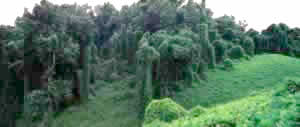
The Natural Georgia Series: Atlanta's Urban Wildlife

 |
The Natural Georgia Series: Atlanta's Urban Wildlife |
 |
 The
Plant Invaders
The
Plant Invaders When we fly over Atlanta, we look down upon an urban forest that shades and softens the harshness of the steel and concrete below. But when we look deeper into the urban forest, we see only the mature canopy of oaks, hickories, and pines and usually a ground layer of a single species such as Fescue Grass or English Ivy. Noxious weeds such as Nepal Grass (Microstegium vimineum) that are tolerant of very low-light conditions often form an impenetrable mat on the forest floor, restricting seed-to-soil contact. The critical native herbaceous and understory layers that provide habitat for a diversity of native wildlife disappear. Consequently, the predominant resident wildlife are small mammals such as squirrels and chipmunks and birds such as woodpeckers and Blue Jays. The urban forest provides most of the food, cover, and nesting habitat for these species.
The native landscape in an urban environment is difficult if not impossible to define. Some plants such as Kudzu (Puereria trilobata) and Japanese Honeysuckle (Lonicera japonica) are so pervasive we tend to think of them as natives rather than as species introduced from other continents. Introduced ornamentals such as crepe myrtle and oriental azaleas are the signature of the southern garden. Our landscapes would certainly be poorer without them. But the effects of introducing exotic species are often not readily apparent. Kudzu, introduced in the 1920s as a fast-growing, ornamental vine, was thought to be a godsend. It was planted all over the state to control horrific erosion and loss of topsoil due to poor farming practices. The rest is history.
Humans can alter the landscape in many ways. Perhaps the greatest threat to wildlife is the insidious "chipping away" of habitat, 5 and 10 acres at a time. Large losses of acreage to development such as shopping malls and airports are front page news. The loss of an acre here and an acre there largely goes unnoticed but has a cumulative negative effect. When residential development occurs, most of the existing vegetation is removed and the topsoil is scraped away in order to build the dwelling. The service areas (driveways and sidewalks) are paved and the remaining available area for landscaping is limited. The builder usually provides a basic palette of foundation plants dictated by availability in the marketplace, and a prescribed square-footage of lawn is installed.
While many plants easily attract butterflies and birds into the garden, the Georgia Wildlife Federation always recommends the use of native species when possible. In the past (and sometimes even today) wildlife managers have promoted exotic species like Autumn Olive (Elaeagnus umbellata) that do attract much wildlife. Unfortunately, Autumn Olive is a fierce competitor that thrives in the toughest conditions, displacing native species and reducing diversity of first the flora and subsequently the fauna.
The immediate effects of commercial development on habitat are apparent. The land is necessarily degraded by the infrastructure required to support such development. Highways and bridges must be built for access. Water and sewage management are essential. Utilities must be provided.
When providing these amenities, alteration of habitat is inevitable. First, when the land is cleared, the native seed bank is removed, and regeneration and natural succession are interrupted. Second, in managed landscapes, exotic ornamentals often replace native vegetation and the ground layer is replaced by a nonnative sod grass or groundcover like English Ivy (Hedera helix). In unmanaged landscapes (vacant lots or wet areas unsuitable for development), aggressive competitors displace native species that often have more specific needs for survival.
The introduction of ornamental exotic species also affects wildlife habitat. Many garden plants such as Chinese Privet (Ligustrum sinense) and Amur Honeysuckle (Lonicera maackii) readily escape cultivation and are spread by birds into other environments. Chinese Privet is a particularly tenacious competitor that thrives in the moist, heavy shade of floodplains like that of the Chattahoochee River or on dry, full-sun highway rights-of-way. Heavenly Bamboo (Nandina domestica) and Oregon Grapeholly (Mahonia bealei) are landscape plants that have been cultivated for over a century and are still planted in gardens. While not quite as pervasive as Chinese Privet, these shrubs spread into nearby woodlands when the oily berries are eaten by many birds and mammals, and the seeds are deposited as the animals travel through the treetops.
Exotic tree species also can spread beyond the garden boundaries. Princess Tree (Paulownia tomentosa) produces prodigious amounts of seed, and the seedlings take root along railroad tracks and bridges and even in the crevices of concrete walls in highway medians. Chinaberry (Melia azedarach) sprouts under power lines and along highways.
An exciting movement in garden and landscape design is the planting of wildflowers and woody shrubs to enhance wildlife habitat. State garden clubs work with departments of transportation to plant highway rights-of-way with wildflowers. The seed mixes usually include showy but nonnative species like California Poppy, Cosmos, Oxeye Daisy, and Queen Anne's Lace. These highly visible projects seen daily by scores of commuters have drawn attention to the vast amount of available land for habitat enrichment. A positive relationship would be to link the garden enthusiasts with botanists and wildlife biologists who can provide guidance for the selection of suitable native species that will create a sustainable habitat for wildlife.
It is critical that ecologists and land managers work together to evaluate the role of exotic plant species in the landscape. In turn, they must share this information with all citizens who have daily impact on the natural environment. Education is key and must be ongoing in an ever-changing urban world.
Read and add comments about this page
Go back to previous page. Go to Atlanta's Urban Wildlife contents page. Go to Sherpa Guides home.